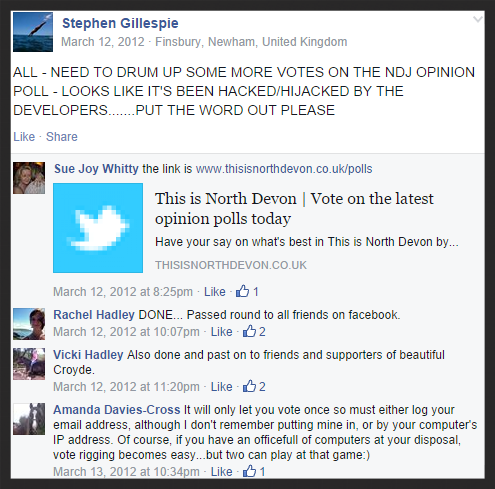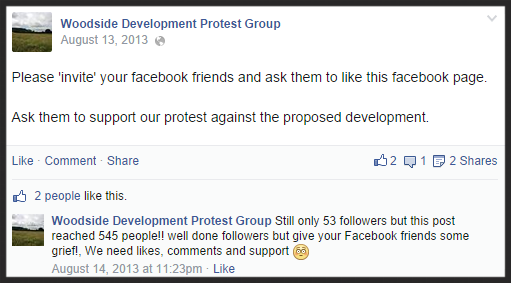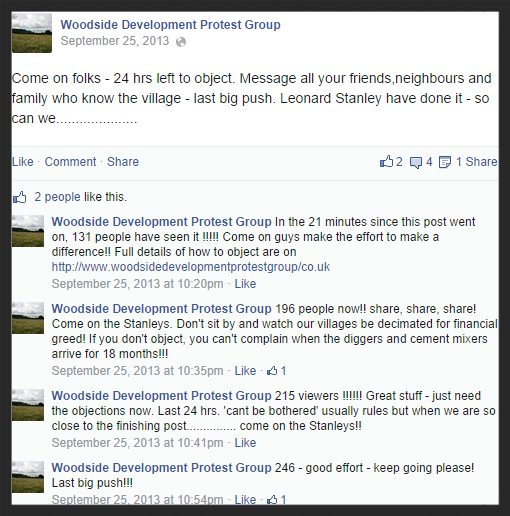How to handle online opposition to development
Opposition to development is nothing new, particularly in a country like ours that’s often accused of being plagued by knee-jerk NIMBYism.
But as the world becomes ever-more digital, the web has opened a new arena for those trying to galvanise support to combat a prospective scheme. The internet has made it easier than ever for like-minded protestors to come together, share their opinions and attempt to prevent developments in areas close to their hearts.
In this guide, we’ll look at the anatomy of an online protest and examine the methods and results of several high-profile, real-life case studies.
Baggy Point hotel development
Back in 2011, residents in and around the village of Croyde in Devon got together to oppose a proposed hotel development on local scenic spot Baggy Point. The group’s bio states:
“The site is viewable from the beach, in the water, the opposite headland and from the protected nature reserve of Baggy Point itself. If this were to go ahead the landscape and views irreversibly spoiled for generations to come.”
Creator Adam David Layland began by adding a handful of people to the group and supplying new members with basic information about the prospective development and how to go about voicing their opposition.
The trickle of new members quickly became a flood, however, and in under 24 hours, the group had accrued more than 100 members (although this could have something to do with the way inviting people to Facebook Groups used to work).
New members were quick to share their – overwhelmingly negative – feelings about the development and the forum quickly became an echo chamber for those voicing their disapproval.
It’s important to note that the views expressed weren’t unequivocally negative, however, with several people trumpeting the economic benefits the hotel could bring.
While many were content to leave their two cents about the proposals on the group page, others attracted the attention of the press by making their opinion clear in more ambitious ways:
In just six days, the group had attracted 1,000 members – supplying them with a forum to air their views, resources on the application and how to object, and regular updates on how the application progressed.
On the back of the objections of locals, the parish council opted to reject the scheme, but the protestors warned against complacency, noting the proposals would still have to be reviewed by the North Devon District Council.
Activity on the group was frantic in the first two months – many brands would envy the amount of engagement the issue fostered among members. Things quietened down after June, however, with updates becoming much less frequent.
Eventually, one of the group’s most prominent members revealed the application had been withdrawn, although it was later noted that a much smaller hotel was proposed to be put in place and this time opposition was much less vocal.
Several discussions also branched off, noting that development at the site seemed inevitable and imploring residents to work constructively to bring about something they could all be happy with.
As the mood seemed to change, there were even accusations of vote rigging:
While the group accrued its first thousand members in six days, by March the following year, it had yet to reach 1,500.
Previously positive members turned sour:
A new hotel application was submitted in the following year, but was met with notably less opposition in the group. According to the NDDC website, this application was deferred by committee.
At the time of writing this article, the hotel application had been replaced by one for a single dwelling, which is currently listed as awaiting an Environmental Impact Assessment for the proposal.
The take-away
So what can the aborted attempts at ushering in a new hotel in Croyde tell us?
Timing: The initial response to the application was vocal and attracted a great deal of engagement from group members. However, as time went on this waned until only the most committed opponents remained active.
Engagement: While the activity in the group was by no means lacklustre, it’s worth noting that only a small proportion of the group’s 1,000+ members ever contributed to the discussion. However, those that were engaged tended to make repeat visits (at least in the group’s early days) – commenting on discussions even when they rehashed old arguments or news.
Even the group’s creator took a backseat in the latter days – content to leave it to the most vociferous opponents of the proposed development.
Constraints of the platform: Facebook is changing the way it works literally all the time, which can make life exponentially harder for groups trying to get noticed.
In the early days of the group, it was easy to opt people in, which led to heady numbers of new members as its reach spread organically through members adding other people they thought might be interested.
However, keeping up-to-date became exponentially harder due to the way Facebook notifications work(ed). Indeed, as one member complained, updates on group activity stopped appearing on her feed/homepage – forcing her to manually navigate to the group to keep up with events.
While no-one knows exactly how Facebook decides what content to put in front of you – its development team will never be done tinkering with the format in order to foster engagement and give users more of what they want.
Woodside Lane
In 2013, Lioncourt Homes proposed building 50 new homes in the Gloucestershire village of King’s Stanley and a Facebook page was set up in protest. As opposed to the ‘members’ we saw in the Baggy Point group, this Facebook page was confined to ‘Likes’ – of which it achieved 67.
This protest group received a much more muted response than Baggy Point and it’s possible that changes to the way Facebook groups function – or the way this one was set up as a ‘page’ – played a role. It’s also worth noting that the page only issued a total of 14 updates and received a handful of posts from others.
The group kicked off by posting an article from The Gloucestershire Citizen, detailing the plight of Andy Wright, a wheelchair user who complained that the proposed development would spoil his view of the nearby greenfield site on which it was planned.
It made a few posts in this vein, before moving on to original content in the form of pictures of the proposed site, calls to action to hand out circulars on the development and news of a dedicated website for the opposition.
The site itself is fairly functional, although updates were infrequent. Details on how to oppose the plan were posted, alongside background to the opposition and reasons as to why the development should be rejected.
Even in the last 24 hours before the deadline for objections, engagement on the page was nowhere to be seen and the page’s admin seemed to confuse the potential reach of posts with interaction.
Despite the page’s lacklustre performance, real-world opposition presumably took up the slack as the proposed development was rejected by Stroud District Council. Although it is currently listed as being appealed, it’s worth noting that activity on the page seems to have ceased.
The take-away: It’s hard to determine the role the lukewarm online opposition played in deterring this application, but the page-style setup clearly garnered less interest than the Baggy Point group. And it’s arguable that the latter method fosters more engagement through user participation.
Given the long life cycle that a planning application can go through, it’s also difficult for groups like this to provide updates during long periods of inactivity.
‘We don’t need a’ Sherborne Tesco
This particularly vocal 2013 campaign went the whole hog in terms of digital engagement, as well as tying in online efforts with offline activities.
Set up to protest a proposed Tesco in Sherborne, Dorset – the campaign’s medium of choice was Twitter and we found no trace of it on Facebook, however, it also benefitted from a dedicated website.
As we’ve seen with the above campaigns, the lion’s share of activity took place in the campaign’s early days. However, No Thanks Tesco were no slackers and kept up a relatively steady pace as the planning process progressed.
At the campaign’s beginning, they capitalised on the reams of negative news surrounding big supermarkets following the horsemeat scandal.
They engaged with Tesco’s corporate profile and shared reports of other stores that had a negative impact on their locality, as well as warnings over a pending price war among the big four.
This tactic seemed to work swimmingly, keeping interested people engaged during the many times when there wasn’t much in the way of ‘big’ news to share about the plight of the proposals.
Campaign organisers were also frighteningly on the ball – lambasting the planning consultancy for apparently making light of feedback for the planned store.
They also used some savvy tactics, capitalising on trending hashtags:
And were keen to share stories of other organisations opposed to the prospective store:
They also branched out into the realms of multimedia with this unforgettable video:
Eventually, the campaign won out – accruing over 11,000 signatures according to Guardian coverage (which is more than the population of the town).
However, a somewhat patronising blog from Tesco on the withdrawal of the plans claimed that the staunch opposition was not a deciding factor.
“We’ve held meetings in the town, talked to supporters and opponents, discussed with the Council and this week we have concluded it won’t work. Protestors will celebrate, but in the end it was planning, not the protest, which drove this conclusion.”
Take Away: No Thanks Tesco were probably the most highly organised opposition group we’ve looked at – and could even teach agencies a valuable lesson in engagement!
They managed to sidestep the frequent voids of ‘hard’ news in the planning process by sharing tangentially related content that was disparaging to the big supermarket chains.
The group also took to a variety of mediums, as demonstrated by their musical adventure on YouTube, Twitter presence, dedicated website and offline activities, which helped generate coverage in the local and national press.
Their choice of platforms also speaks volumes about how dramatically the social media landscape had changed in the two years since the Baggy Point group was set up.
Insights
So what insights can we glean from the above examples and the growing use of online channels to garner opposition to development?
Ignorance is no longer bliss: One frequent issue we’ve come across when suggesting the inclusion of social media in the public consultation mix is that a development page will simply provide angry NIMBYs with a forum to congregate and criticise the proposals.
While this certainly isn’t an unfounded allegation – the fact of the matter is these conversations are going to take place whether you participate or not.
If you do opt to take the proverbial bull by the horns, you can at least go some way to demonstrating your commitment to stakeholders and balancing the echo chamber of negative sentiment with positive facts about the benefits of a proposed development.
It’s a marathon, not a sprint: The long cycle of the planning process can be a great hindrance to online opposition – leaving vast swathes of time where nothing newsworthy occurs.
In two out of three cases, we saw online opposition flag during these periods. This leaves two options for invested parties. Firstly, they could promote their positive messages about the development on social platforms and then let opposition peter itself out.
Alternatively, they could attempt to fill the intervening gaps by reiterating their positive messages – although this risks giving their opposition something to galvanise around.
Respect: While it may be tempting to write off those who are opposed to a development as mere NIMBYs, they are real people with real concerns.
Tesco exemplified this in the backhanded way it acknowledged the Sherborne opposition, while claiming it played no part in the decision not to push ahead with plans for the store.
While public consultations have always been important, the dawn of digital has opened a whole new dimension for groups looking to discuss or oppose developments. And while it may be tempting to take a head-in-the-sand approach to online mediums – it may not be an option for much longer.
And You?
Do you have any good examples of opposition to development or thoughts you’d like to share? If so, leave us a comment below or fire us a tweet – we always love to hear what you have to say.
And if you’re looking for advice on how to incorporate social media into your public consultation, or have any queries about its use in property marketing, download our free guide for property companies today:
Selected industry experts bring you insight and expert advice, across a range of sectors.
Subscribe for free to receive our fortnightly round-up of property tips and expertise
Selected industry experts bring you insight and expert advice, across a range of sectors.
Subscribe for free to receive our fortnightly round-up of property tips and expertise




















